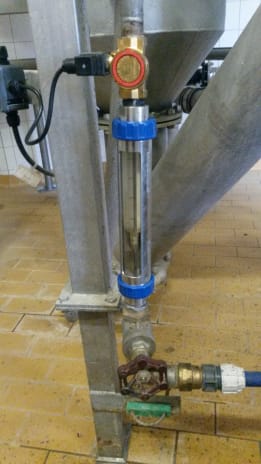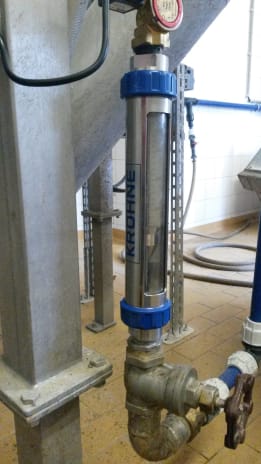Monitoring the flow of rinse water in a grit washing plant
Application Report | Water & Wastewater
- Safeguarding the water supply for organic separation using a grit classifier
- Early detection of a blocked rinse water supply pipe
- Cost-effective variable area flow measurement without power supply

Background
The ZWAG Association for Drinking Water Supply and Wastewater Disposal in Braunsbedra, Germany, operates a municipal central wastewater treatment plant. The plant is designed to clean the wastewater of up to 23,000 residents both mechanically and biologically and to have that wastewater undergo sludge treatment.
Measurement requirements
Before transitioning from the mechanical to the biological purification stage, the treated sand settled in the sand trap is removed from the process and fed into a grit washing plant. A grit washing classifier is used to wash down the sediment to an organic content that complies with legal requirements.
The grit washing classifier is adjusted once to an appropriate rinse water volume for the cleaning process. The rinse volume must remain constant throughout the operation but otherwise requires no other adjustments. However, if the volume flow drops or if there is no more rinse water at all, that indicates a blockage in the rinse water supply pipe that must be cleared. To guarantee that the grit washing plant would operate efficiently, the plant operator decided to monitor the rinse water flow continuously.
KROHNE Solution
The ZWAG sewage treatment plant operator monitors the rinse water flow using the VA 40 variable area flowmeter. It is installed directly into the corresponding DN 32 rinse water line in front of the grit washing classifier via a G2 thread connection. The customer operates the device thanks to the simple mechanical measuring principle without power supply. It has just one local display that the customer monitors from time to time. To do this, the VA 40 features a glass cone which enables direct reading of the flow. The KROHNE device is well protected by a metal cover with a sight glass. This makes it extremely robust and well suited for use in the harsh environment of the wastewater treatment plant.
Customer benefits
As this application is not process-relevant for the actual sewage treatment operation, the reliable and extremely cost-effective variable area flow measurement is completely adequate for the customer. Neither automation nor extremely high accuracy are required here, which means that the customer can operate the measuring point with the help of the VA 40 in a cost-saving and energy self-sufficient way. At the same time, the reliable and durable KROHNE device guarantees that the customer can detect the need for maintenance in the rinse water supply at any time.
If the customer needs to transmit the measuring results at a later time directly to the control room, a VA 40 with 4…20 mA analogue output could also be used. The use of a different variable area flowmeter with additional communication options such as Fieldbus would also be possible upon customer request. As one of the leading suppliers, KROHNE has contributed greatly to bringing variable area flow measurement technology up to today's standard and that is why it offers the option of digital data transmission for many of its variable area devices.




